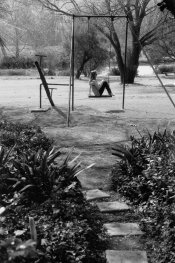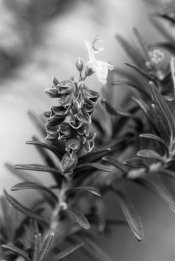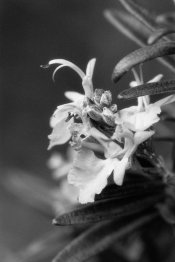dorff
Member
Over the weekend I decided to give a rosemary developer a try. The idea stems from the "Edible Film Developer" thread that went on for seemingly ever, but which never produced a real formula, so to speak. Since most of the natural developing compounds are acids with fairly low solubility in water, I decided to add 2g of caustic soda (NaOH) to get the sodium salt which should theoretically be more soluble. In addition, most of these compounds are not active enough on their own, and like phenidone and coffee, seemed like candidates for ascorbate. Rosemary contains rosmarinic acid which is the prime suspect as a film developer in this plant, as it is related to caffeic acid. So the formula is:
110 g of fresh rosemary shoots (it's about two handfuls - it seemed like the right amount to use)
2 g caustic soda in one liter of water
Boil for 20 minutes in a stainless steel saucepan, strain and rinse out the leaves with a final 100 ml or so of water, press out the last liquid as far as possible and cast through a tea sieve. Ignore the green appearance. Try to ignore the aroma , or do this part outside.
, or do this part outside.
Allow to cool down. Add a further 14.7 g of caustic soda, 42.8 g baking soda and 18 g sodium ascorbate (or use the rest of the Caffenol C-H recipe).
I used Lucky SHD100 as it is the cheapest film I have available. It was developed for 15 min at 20 deg C. The results are:




I have seen quite few photographs of coffee mugs and coffee beans developed in caffenol, so I thought a rosmarinol test should at least contain a photo or two of rosemary. And what is a photo thread without a cat. The film looks as if it was developed normally in Rodinal or HC-110. No tint or stain, and not too much fogging as far as I can see. I also tried Kentmere 400, which produced slightly more fog but still very usable images, very similar to Rodinal.
Any ideas welcome, especially if you are going to try them yourselves. My son complained bitterly about the smell, and in hindsight it is a project to be done outdoors, or when you are alone at home. Also, it is a lot more work than mixing Rodinal, so try it if you are after adventure, not convenience.
A final note: Caustic soda and potassium hydroxide react with aluminium, the hotter and more concentrated the solution, the more vigorous the reaction. Do NOT use aluminium saucepans or utensils with hydroxides. The byproduct of this reaction is hydrogen, which is flammable and/or explosive. Be careful.
dorff
110 g of fresh rosemary shoots (it's about two handfuls - it seemed like the right amount to use)
2 g caustic soda in one liter of water
Boil for 20 minutes in a stainless steel saucepan, strain and rinse out the leaves with a final 100 ml or so of water, press out the last liquid as far as possible and cast through a tea sieve. Ignore the green appearance. Try to ignore the aroma
 , or do this part outside.
, or do this part outside.Allow to cool down. Add a further 14.7 g of caustic soda, 42.8 g baking soda and 18 g sodium ascorbate (or use the rest of the Caffenol C-H recipe).
I used Lucky SHD100 as it is the cheapest film I have available. It was developed for 15 min at 20 deg C. The results are:




I have seen quite few photographs of coffee mugs and coffee beans developed in caffenol, so I thought a rosmarinol test should at least contain a photo or two of rosemary. And what is a photo thread without a cat. The film looks as if it was developed normally in Rodinal or HC-110. No tint or stain, and not too much fogging as far as I can see. I also tried Kentmere 400, which produced slightly more fog but still very usable images, very similar to Rodinal.
Any ideas welcome, especially if you are going to try them yourselves. My son complained bitterly about the smell, and in hindsight it is a project to be done outdoors, or when you are alone at home. Also, it is a lot more work than mixing Rodinal, so try it if you are after adventure, not convenience.
A final note: Caustic soda and potassium hydroxide react with aluminium, the hotter and more concentrated the solution, the more vigorous the reaction. Do NOT use aluminium saucepans or utensils with hydroxides. The byproduct of this reaction is hydrogen, which is flammable and/or explosive. Be careful.
dorff












